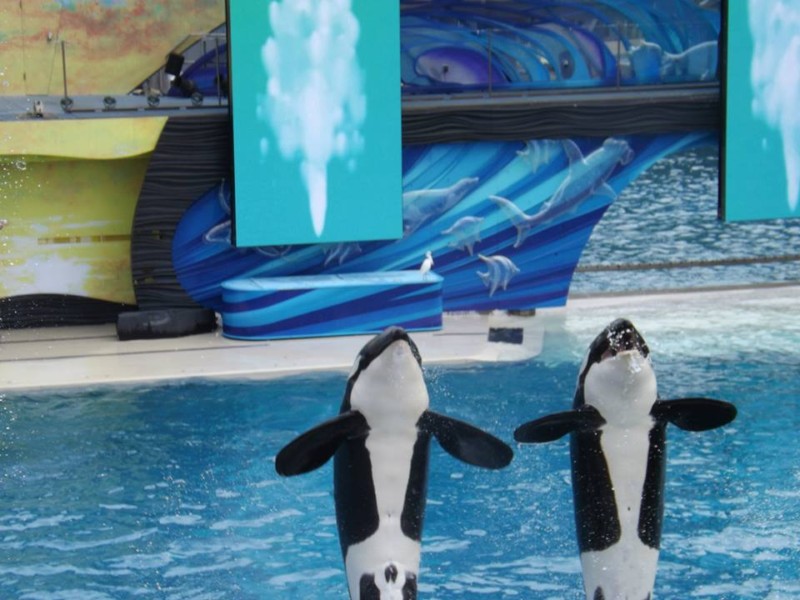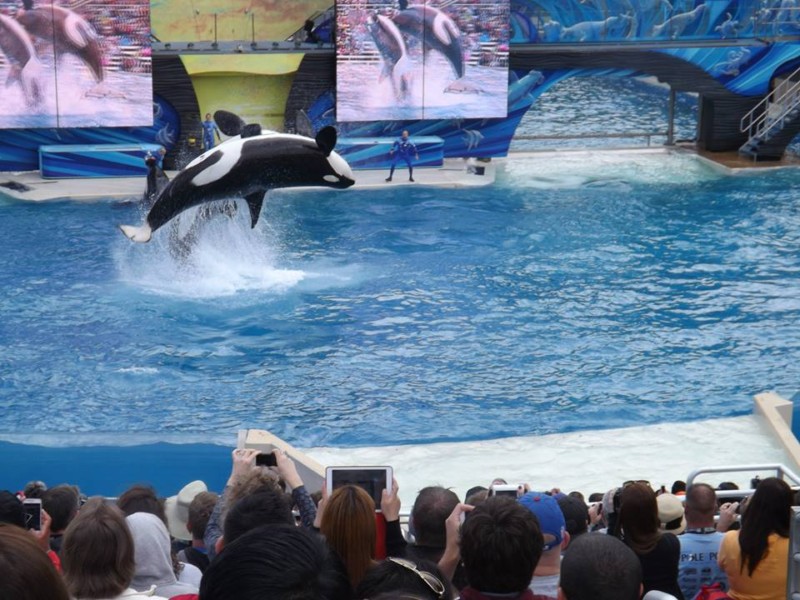On April 8, 2014, California Assembly Bill 2140, proposing an end to killer whale performances and captivity in the state, was heard before the Assembly Water, Parks, and Wildlife Committee. InPark News Editor Joe Kleiman was inside the hearing room in the State Capitol Building to document the proceedings for IPM. After the hearing, he met with SeaWorld’s testifying witnesses, including San Diego park President John Reilly, and with the bill’s author, Assemblyman Richard Bloom of Santa Monica.
In all there were around 150 members of the public present for the hearing – 50 of us inside the room, the remainder watching on a monitor in the adjacent hallway. The majority attending were individuals or representatives of animal rights groups, a number from out of state, in support of the bill. But there was also a sizable delegation of those opposed, including regional and state economic and tourism associations, and the majority of the state’s zoos and aquariums, which were represented by Mary Healy, Director of the Sacramento Zoo and President of the California Association of Zoos and Aquariums (CAZA), and Jim Maddy, the President and CEO of the Association of Zoos and Aquariums (AZA), which he stated before the committee accredits “twenty-two zoos and aquariums in California and we strongly oppose this legislation.”
In an interview conducted after the hearing, Healy explained the concerns that she and other zoo and aquarium administrators within California have about the bill: “Animal extremists have created a systematic plan to compromise what zoos do best, which is conservation, especially of endangered species, and inspiring people through our animal collections to care about the natural world.” Healy pointed out that AZA member zoos have a high level of standards and procedures that have been solidified over time. According to her, the bill would take decisions of animal acquisition and disposition away from those best qualified. “When politicians dictate how zoo animals should be cared for, it takes the expertise and the experts in animal care out of the equation.”
Via email correspondence prior to the hearing, Dr. Naomi Rose, who represents the Animal Welfare Institute, co-sponsor of the bill, told me that she does “not see how it will affect housing for animals in zoos, since the bill targets only one species, with unique biological and ecological characteristics that make it unsuited to captivity.” But the state’s zoos worry that the implications of the bill will spread beyond orcas. As he closed the portion of the hearing on the orca bill, Committee Chair Anthony Rendon stated, “I’m fundamentally opposed, I am ethically opposed, to holding large mammals in captivity.” Healy of the California Association of Zoos & Aquariums takes that to heart. “This bill does not technically threaten other animals,” she told me, “But when the Committee Chairman says he’s opposed to large mammals in captivity, that’s a threat to all of our member zoos. All of our zoos were behind me when I went up and said I opposed the bill.”
A BRIEF HISTORY OF AB-2140
At the root of the bill is the controversial documentary Blackfish, which on its surface explores the events leading up to the 2010 death of SeaWorld Orlando orca trainer Dawn Brancheau, but which is widely accepted as being a film about animal rights. SeaWorld has countered the claims in the film with an extensive media campaign, using both traditional legacy and social media strategies. The company’s official statement on the film reads in part:
We object to “Blackfish” because its two central premises are wrong: (1) that life at SeaWorld is harmful for killer whales and for trainers working with these animals, and (2) that SeaWorld has attempted to cover up the facts surrounding the tragic death of trainer Dawn Brancheau in 2010, as well the history of Tilikum, the killer whale involved in that accident. Nothing could be further from the truth.
To make these ultimately false and misleading points, the film conveys falsehoods, manipulates viewers emotionally, and relies on questionable filmmaking techniques to create “facts” that support its point of view.
. . . All of the falsehoods and misleading techniques in “Blackfish” are employed in the service of the film’s obvious bias, one that is best revealed near the end of “Blackfish” by a neuroscientist with no known expertise in killer whales. She claims that all killer whales in captivity are “emotionally destroyed,” and “ticking time bombs.” These are not the words of science, and indeed, there is not a shred of scientific support for them. Rather, they are the words of animal rights activists whose agenda the film’s many falsehoods were designed to advance. They reveal “Blackfish” not as an objective documentary, but as propaganda.
The film played over twenty times on CNN and through the social media efforts of those in the animal rights movement, became a leading tool utilized by a number of organizations and individuals dedicated to freeing the theme park chain’s orcas. Bloom, who served a three-year term on the California Coastal Commission, has a history of environmental legislation, including another current bill that would remove plastic microbeads from skin care products. He was encouraged to see the film and afterwards was put in touch with Dr. Naomi Rose, an adviser on the film who has been fighting orca captivity for close to two decades. Rose and other scientist-advocates helped Bloom draft the Orca Welfare and Safety Act, which eventually became AB-2140.
The bill was introduced on February 20 in order to make the February 21 deadline for the introduction of new legislation. In its inital form, it was nothing more than minor wording changes to the Fish and Game Code Section 701.3, which lists the duties of the Director of the State’s Department of Fish and Wildlife. This was done to make sure the bill would be heard in the current legislative session although it was not actually ready to be introduced. On March 7, the bill was announced at a press conference at the Santa Monica Pier, and on March 28, it was re-written, taking out the provisions about the Director of Fish and Wildlife and inserting the proposed regulations on Orcas. It was then assigned to two committees, the first being the Water, Parks and Wildlife Committee on April 8. Had it passed this committee, it next would be heard in front of the The Arts, Entertainment, Sports, Tourism & Internet Media Committee. Many believe that SeaWorld would have the upper hand in this second committee hearing as it’s where the potential negative economic impact of the bill to the park, San Diego, and Southern California tourism would be discussed.
The bill, at its simplest interpretation, consists of four key components:
- It prohibits the use of orcas for performances or entertainment purposes. This includes people in close proximity to the animals without an “appropriate” barrier.
- It prohibits both natural and artificial reproduction of captive orcas and the export of sperm or eggs for artificial insemination purposes outside the state.
- It prohibits the sale, trade, or movement of any orca within state lines.
- It requires all orcas in captivity prior to enactment of the bill to eventually be released to the wild or to sea pens.
THE BILL’S SPONSORS GIVE THEIR ARGUMENT IN FAVOR
Testifying in favor of the bill were Assemblyman Bloom, Dr. Rose, doctoral student Deborah Giles of the University of California Davis Biotelemetry Laboratory, and John Hargrove, a former SeaWorld senior orca trainer with experience in both the chain’s Texas and San Diego parks.
After arguing that captive conditions are not representative of orcas in the wild, Bloom countered a number of claims that have been made in the media about the bill. He said that even though it prohibits breeding, the orcas can remain on display for at least another two decades, that the bill “does not mandate the release of SeaWorld’s orcas back into the wild [sea pens are not considered being in the “wild” by the bill’s authors as they are controlled environments],” and that “the bill does not prevent trainers from interacting with the orcas . . . rather it prevents them from continuing what many consider glorified circus acts.” Bloom went on to mention the National Aquarium in Baltimore and Shamu Up Close, a program at SeaWorld Orlando in place while the main orca tank was being refurbished, as examples of what he considers appropriate marine mammal displays.
Dr. Rose spoke of a number of characteristics she’s seen in SeaWorld’s orcas which she has not in their wild counterparts, including collapsed dorsal fins in males, worn down teeth, and signs of aggression. She believes that transfering the animals to sea pens would result in them exhibiting a more natural behavior.
Giles argued that the intermixing of different populations of orcas from the Pacific and the Atlantic is unnatural and would never happen in nature. She stated that hybrids with parents from each ocean serve no conservation purpose and that placing the orcas into sea pens would allow them to live in a more “natural and dignified manner.”
John Hargrove, speaking on behalf of himself and two other former trainers that appear in “Blackfish,” Carol Ray and Samantha Berg, spoke about what he considers “obsessive compusive” behavior caused by boredom of the orcas, which he says results in continued physical damage to the animals.
SEA WORLD ARGUES AGAINST THE BILL
NOTE: Portions of my interviews with SeaWorld’s witnesses conducted after the hearing are included here along with their testimony.
Testifying for SeaWorld were:
John Reilly, president, SeaWorld San Diego
Dr. Chris Dold, vice president of veterinary services, SeaWorld Parks & Entertainment
Dr. Pam Yochem, executive vice president, Hubbs-Seaworld Research Institute.
Dr. Shawn Noren, associate researcher, Institute of Marine Science, University of California, Santa Cruz
Scott Wetch, lobbyist, Carter, Wetch and Associates
Reilly discussed much of the good that SeaWorld has done for the people of California – last year, the park paid $14 million to the City of San Diego, was an important component in steering $18.7 billion into the area’s tourism economy, and is San Diego’s tenth largest employer. He expressed concern that a ban on shows would be detrimental to both the orcas’ physical and behavioral health, and that separating trainers from orcas would create trust issues with the animals.
Reilly also brought up that one of the benefits to the public of having animals in its parks is that it allows access to them for scientific research. One of those researchers is Dr. Shawn Noren, of the Institute of Marine Sciences at the University of California, Santa Cruz. Dr. Noren is currently studying bioenergetics, the movement of energy flow through living systems, in Pacific walruses, a species being considered for listing under the Endangered Species Act. Because she studies walrus pups, and it is nearly impossible to approach one in the wild for the kind of work she does, she relies on zoological institutions such as SeaWorld at which she can her conduct research.
Dr. Pam Yochem of the Hubbs-SeaWorld Research Institute, who has a degree in veterinary medicine from the University of California, Davis, explained during her testimony that the bill would cripple the opportunity to research orcas. As remote observation is not a viable option for much of this research, captive research becomes an instrument for progressing wild research.
Dr. Chris Dold, SeaWorld’s head of veterinary medicine, expanded upon this further. I asked him about the proposed ban on reproduction and he pointed out, “The Southern Resident population of orcas in Washington is seeing a major decrease in numbers. We don’t know why they’re not reproducing like they should. But when our whales are pregnant, be it natural or through artificial means, there are researchers that come to our parks and study the gestation period, that monitor the pregnancy.” Dold pointed out that it does not matter where the orca is from, reproductive biology in all orca populations is the same. That research then gets peer reviewed and published in scientific journals. This kind of research is, according to Dold, Yochem, and Noren, something that could absolutely not be conducted in the wild.
SEA PENS AND AFTERMATH
One of the most controversial parts of the bill calls for the current group of ten orcas in San Diego to be removed to sea pens, with the exception of Corky, captured in 1969 in British Columbia, which the bill’s backers believe can be reunited with her pod. While those testifying in favor of the bill declared how moving SeaWorld’s orcas from concrete tanks to sea pens would provide them with a more natural environment, SeaWorld’s scientific and veterinary witnesses expressed concerns that placing the whales into these partial-natural environments could be detrimental. It would be impossible to keep the orcas in SeaPens in the vicinity of San Diego, where the water temperature can reach into the 70’s for an animal whose tank temperature is at 58-62 F, according to Dolt.
Noren and Yochem brought up a number of other key factors that need to be taken into consideration – toxic runoff from agriculture and industry, red tide (a toxic algae bloom found along the Southern California coast), the potential for nets coming lose or ripped, key areas along the California coast being hunting grounds for great white sharks, and the possibility that other animals, especially protected species, might get caught in the nets. Noren referred to it as “going through the issues we had with ocean-based fish farms all over again.”
Scott Wetch, a lobbyist hired to represent SeaWorld, pointed out that removing the orcas from the parks to sea pens would fall under a provision of the Fifth Amendment of the United States Constitution, which states “nor shall private property be taken for public use, without just compensation.” Wetch alluded to the fact that the animals are worth “hundreds of millions of dollars” and reminded the committee that under the Fifth Amendment, “You ban them, you buy them.”
At the end of the hearing was a Q&A period between the council members and the witnesses. When asked about safety, Reilly stated that since SeaWorld opened, there have been over two million water work (in the water with the whales) interactions, after the death of Brancheau in 2010, the park invested $70 million in infrastructure, including a new lifting floor in the main tank that can rise in just 20 seconds. and had redesigned spotter protocols. Reilly said, “There were just over 100 incidences themselves that SeaWorld documented out of those two million, and less than a dozen or so that required medical attention. We take every one of those injuries that required medical attention quite seriously, which is why we continue to invest in infrastructure and new protocols.”
According to Reilly, since opening in 1964, 153 million people have visited SeaWorld San Diego. Since SeaWorld’s first orca, Shamu, arrived at the park in 1965, 150 million people have seen orcas in the parks. Dolt added that at SeaWorld San Diego, there are currently 10 orcas. The chain is responsible for 29 orcas at its parks and partner locations worldwide, and there are around 50 in all at aquariums and theme parks worldwide. When asked about how many orcas are in the wild, Dolt deffered to Naomi Rose, who shared that it is estimated at between 50,000 and 100,000.
Because the sea pen idea is currently “blue sky,” without a plan in place, a number of council members were hesitant to vote on the bill. It was placed into interim study. According to the Chief Clerk of the Assembly, interim study is “the assignment of the subject matter of a bill to the appropriate committee for study during the period the Legislature is not in session.” This means the bill will likely not see committee again until 2015. To find out more about the next steps of the process, I visited Assemblyman Bloom in his Capitol office.
“I’m very pleased with this decision. It’s a step forward with the issue,” he said. “This gives me some time to talk with my colleagues who had unease in moving forward.”
According to Bloom, all the stakeholders will now have a role in the process. The end result he believes will be an end to captive breeding and performances.
Bloom expects one or more public hearings. “Scientists will get together and discuss the merits of this bill and help redefine it. There will be a longer period for research and discussion and a more relaxed atmosphere in which to discuss it.”
SeaWorld San Diego continues with its 50th Anniversary celebration, having just opened it’s new interactive grand entrance, “Explorer’s Reef,” and the park is preparing for a new nighttime orca show that will premiere this Summer. The move of the bill to a period of interim study will allow the park time to evaluate its approach and also to participate in discussions with others who have a stake in the matter.
In our interview after the hearing, UC Santa Cruz’s Shawn Noren told me, “If you go to see them at a distance in a sea pen, you’ll be lucky if you see a dorsal fin or an eye patch. And you’re very likely never to see the face of the animal at all.” Park President John Reilly agrees, “We really seek to inspire our guests to care about the oceans and its animals – especially through our orcas – by giving them the opportunity to see them close up in a way they never could in the wild.”








